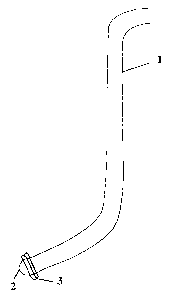Some of the information on this Web page has been provided by external sources. The Government of Canada is not responsible for the accuracy, reliability or currency of the information supplied by external sources. Users wishing to rely upon this information should consult directly with the source of the information. Content provided by external sources is not subject to official languages, privacy and accessibility requirements.
Any discrepancies in the text and image of the Claims and Abstract are due to differing posting times. Text of the Claims and Abstract are posted:
| (12) Patent Application: | (11) CA 2343544 |
|---|---|
| (54) English Title: | ARRANGEMENT RELATED TO RISER PIPELINES |
| (54) French Title: | MONTAGE POUR PIPELINES DE COLONNE MONTANTE |
| Status: | Deemed Abandoned and Beyond the Period of Reinstatement - Pending Response to Notice of Disregarded Communication |
| (51) International Patent Classification (IPC): |
|
|---|---|
| (72) Inventors : |
|
| (73) Owners : |
|
| (71) Applicants : |
|
| (74) Agent: | SMART & BIGGAR LP |
| (74) Associate agent: | |
| (45) Issued: | |
| (22) Filed Date: | 2001-04-09 |
| (41) Open to Public Inspection: | 2002-10-09 |
| Examination requested: | 2006-03-21 |
| Availability of licence: | N/A |
| Dedicated to the Public: | N/A |
| (25) Language of filing: | English |
| Patent Cooperation Treaty (PCT): | No |
|---|
| (30) Application Priority Data: | None |
|---|
A device in connection with a riser for the transport of oil and/or gas,
possibly including
water, from a transport system, transport pipe (5) or similar on the sea bed
to a platform
or similar. The solution is characterised in that, in order to use a riser (1)
for the
transport of oil and/or gas from a small field with low oil/gas production
where a
transport pipe (5) with a small diameter is used, a flexible pipe (4) with
generally the
same internal diameter as the transport pipe (5) is arranged inside the riser
(1). At its
upper and lower ends, the riser (1) is provided with a coupling (6, 7), which
forms a seal
between the transport pipe (5) and the flexible pipe (4) and also forms a seal
at the ends
of the riser so that it is closed.
Note: Claims are shown in the official language in which they were submitted.
Note: Descriptions are shown in the official language in which they were submitted.

2024-08-01:As part of the Next Generation Patents (NGP) transition, the Canadian Patents Database (CPD) now contains a more detailed Event History, which replicates the Event Log of our new back-office solution.
Please note that "Inactive:" events refers to events no longer in use in our new back-office solution.
For a clearer understanding of the status of the application/patent presented on this page, the site Disclaimer , as well as the definitions for Patent , Event History , Maintenance Fee and Payment History should be consulted.
| Description | Date |
|---|---|
| Application Not Reinstated by Deadline | 2008-04-09 |
| Time Limit for Reversal Expired | 2008-04-09 |
| Deemed Abandoned - Failure to Respond to Maintenance Fee Notice | 2007-04-10 |
| Letter Sent | 2006-04-04 |
| Request for Examination Received | 2006-03-21 |
| Request for Examination Requirements Determined Compliant | 2006-03-21 |
| All Requirements for Examination Determined Compliant | 2006-03-21 |
| Inactive: IPC from MCD | 2006-03-12 |
| Application Published (Open to Public Inspection) | 2002-10-09 |
| Inactive: Cover page published | 2002-10-08 |
| Inactive: First IPC assigned | 2001-07-12 |
| Letter Sent | 2001-06-07 |
| Inactive: Correspondence - Transfer | 2001-05-17 |
| Inactive: Courtesy letter - Evidence | 2001-05-15 |
| Application Received - Regular National | 2001-05-09 |
| Filing Requirements Determined Compliant | 2001-05-09 |
| Inactive: Filing certificate - No RFE (English) | 2001-05-09 |
| Inactive: Single transfer | 2001-05-08 |
| Abandonment Date | Reason | Reinstatement Date |
|---|---|---|
| 2007-04-10 |
The last payment was received on 2006-03-08
Note : If the full payment has not been received on or before the date indicated, a further fee may be required which may be one of the following
Please refer to the CIPO Patent Fees web page to see all current fee amounts.
| Fee Type | Anniversary Year | Due Date | Paid Date |
|---|---|---|---|
| Application fee - standard | 2001-04-09 | ||
| Registration of a document | 2001-05-08 | ||
| MF (application, 2nd anniv.) - standard | 02 | 2003-04-09 | 2003-03-07 |
| MF (application, 3rd anniv.) - standard | 03 | 2004-04-09 | 2004-03-05 |
| MF (application, 4th anniv.) - standard | 04 | 2005-04-11 | 2005-03-07 |
| MF (application, 5th anniv.) - standard | 05 | 2006-04-10 | 2006-03-08 |
| Request for examination - standard | 2006-03-21 |
Note: Records showing the ownership history in alphabetical order.
| Current Owners on Record |
|---|
| NORSK HYDRO ASA |
| Past Owners on Record |
|---|
| HARALD ARNT FRIISK |